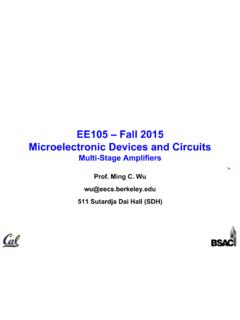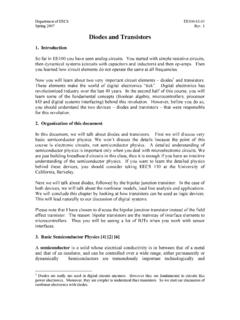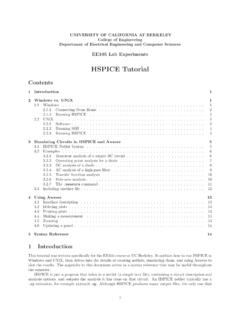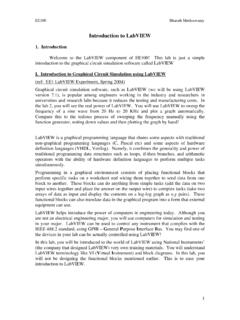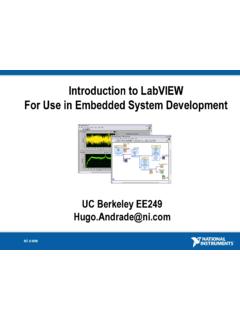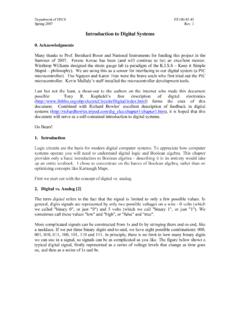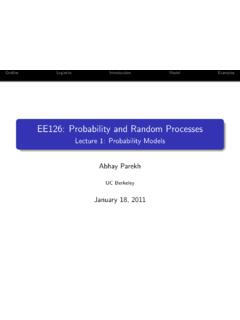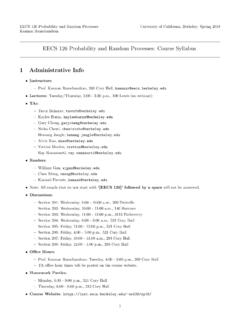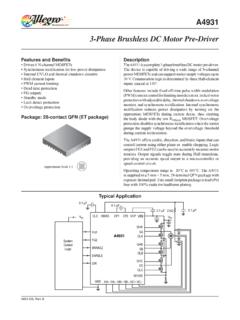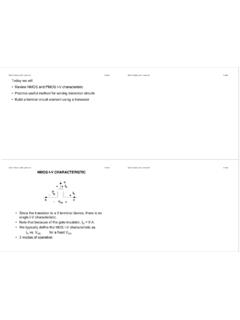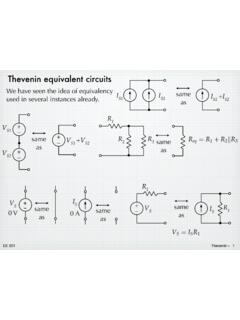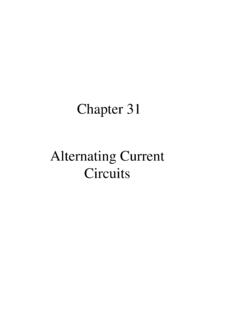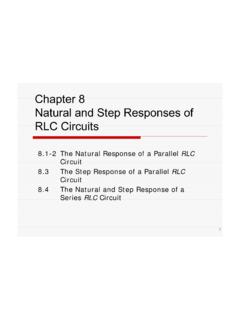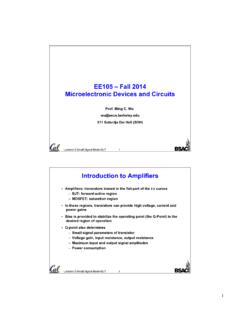Transcription of EE105 – Fall 2014 Microelectronic Devices and Circuits
1 1 1 Lecture13-Small Signal Model-MOSFET EE105 Fall 2014 Microelectronic Devices and Circuits Prof. Ming C. Wu 511 Sutardja Dai Hall (SDH) 2 Lecture13-Small Signal Model-MOSFET Small-Signal Operation MOSFET Small-Signal Model - Summary Since gate is insulated from channel by gate-oxide input resistance of transistor is infinite. Small-signal parameters are controlled by the Q-point. For the same operating point, MOSFET has lower transconductance and an output resistance that is similar to the BJT. Transconductance: gm=2 IDVGS VTN=2 KnIDOutput resistance: ro=1go=1+ VDS ID 1 IDAmplification factor for lVDS<<1: f=gmro=1+ VDS ID 1 2 KnIDIG=0ID=Kn2 VGS VTN()21+ VDS()2 3 Lecture13-Small Signal Model-MOSFET MOSFET Small-Signal Operation Body Effect in Four-terminal MOSFETs gmb= iD vBSQ-point= iD vSBQ-pointgmb= iD VTN#$%%%&'((( VTN vSB#$%%%&'(((Q-point= ( gm )=gm Drain current depends on threshold voltage which in turn depends on vSB.))))))
2 Back-gate transconductance is: 0 < < 3 is called the back-gate transconductance parameter. bulk terminal is a reverse-biased diode. Hence, no conductance from the bulk terminal to other terminals. 4 Lecture13-Small Signal Model-MOSFET MOSFET Small-Signal Operation Small-Signal Model for PMOS Transistor For a PMOS transistor Positive signal voltage vgg reduces source-gate voltage of the PMOS transistor causing decrease in total current exiting the drain, equivalent to an increase in the signal current entering the drain. The NMOS and PMOS small-signal models are the same! vSG=VGG vggiD=ID id3 5 Lecture13-Small Signal Model-MOSFET Common-Source Amplifiers Small-Signal Analysis - ac Equivalent circuit ac equivalent circuit is constructed by assuming that all capacitances have zero impedance at signal frequency and dc voltage sources are ac ground.
3 6 Lecture13-Small Signal Model-MOSFET Common-Source Amplifiers Small-Signal Equivalent circuit Input voltage is applied to the gate terminal Output signal appears at the drain terminal Source is common to both input and output signals Thus circuit is termed a Common-Source (C-S) Amplifier. The terminal gain of the C-S amplifier is the gain from the gate terminal to the drain terminal AvtCE=vdvg= gmRL RL=roRDR34 7 Lecture13-Small Signal Model-MOSFET Common-Source Amplifiers Input Resistance and Signal-Source Gain Define RiG as the input resistance looking into the base of the transistor. Rin is the resistance presented to vi The signal source voltage gain is: RiG=vgii=RGRin=RI+RGAvCS=vovi=vovgvgvi=A vtCSRGRI+RGAvCS= gmRLRGRI+RG"#$%&'8 Lecture13-Small Signal Model-MOSFET Common-Source Amplifiers Rule of Thumb Design Estimate AvCS= gmRLRGRI+RG"#$%&' AvtCS AvtCS= gmRL RL=roRDR3 Typically: ro>>RD and R3>>RD AvCS gmRD= IDRDVGS VTN2"#$%&'IDRD represents the voltage dropped across drain resistor RDA typical design point is IDRD=VDD2 with VGS VTN=1 V AvCS VDDOur rule-of-thumb estimate for the C-S amplifier:the voltage gain equals the power supply that this is 10 times smaller than that for the BJT!
4 5 9 Lecture13-Small Signal Model-MOSFET Common-Source Amplifiers Voltage Gain Example Problem: Calculate voltage gain, input resistance and maximum input signal level for a common-source amplifier with a specified Q-point Given data: Kn = mA/V2, VTN = 1 V, = , Q-point is ( mA, V) Assumptions: Transistor is in the active region. Signals are low enough to be considered small signals. Analysis: gm=2 KnID1+ VDS()= mS ro= 1+VDSID=328 k RG=R1R2=892 k RL=roRDR3= k 10 Lecture13-Small Signal Model-MOSFET Common-Source Amplifiers Voltage Gain Example (cont.) gm= mS ro=328 k RG=892 k RL= k AvCS= gmRLRGRI+RG#$%&'(= ()892k 1k +892k #$%&'(= ()= +RG=893 k vgs=viRGRI+RG#$%&'( viRGRI+RG#$%&'( VTN()VGS VTN 2 IDKn= V vi ()893k 892k #$%&'(= VCheck the rule-of-thumb estimate: AvCS VDD= 12 V (ballpark estimate)6 11 Lecture13-Small Signal Model-MOSFET C-E and C-S Amplifiers Output Resistance 12 Lecture13-Small Signal Model-MOSFET C-E and C-S Amplifiers Output Resistance (cont.))))))
5 For comparable bias points, output resistances of C-S and C-E amplifiers are similar. Apply test source vx and find ix (with vi = 0)vbe=0 gmvbe=0 Rout=vxix=RCro Rout RC for ro>>RCvgs=0 gmvgs=0 Rout=vxix=RDro Rout RD for ro>>RD7 13 Lecture13-Small Signal Model-MOSFET BJT and FET Small-Signal Model Summary 14 Lecture13-Small Signal Model-MOSFET Common-Emitter / Common-Source Amplifiers Summary 8 15 Lecture13-Small Signal Model-MOSFET Amplifier Power Dissipation Static power dissipation in amplifiers is found from their dc equivalent Circuits . (a) Total power dissipated in BJT: PD = VCE IC + VBE IB Total power supplied is: PS = VCC ( IC + I2 ) (b) Total power dissipated in MOSFET: PD = VDS ID Total power supplied is: PS = VDD ( ID + I2 ) 16 Lecture13-Small Signal Model-MOSFET Amplifier Signal Range Similarly for MOSFETs: VM minIDRD,(VDS (VGS VTN))#$%&'( vCE=VCE Vmsin t where Vm is the output signal.)
6 Active region operation requires vCE vBE So: Vm VCE VBEAlso: vRct()=ICRC Vmsin t 0 Vm minICRC,VCE VBE()%&'()
